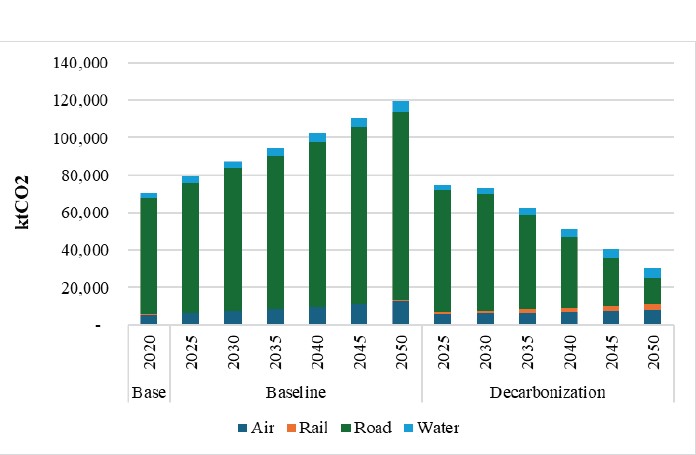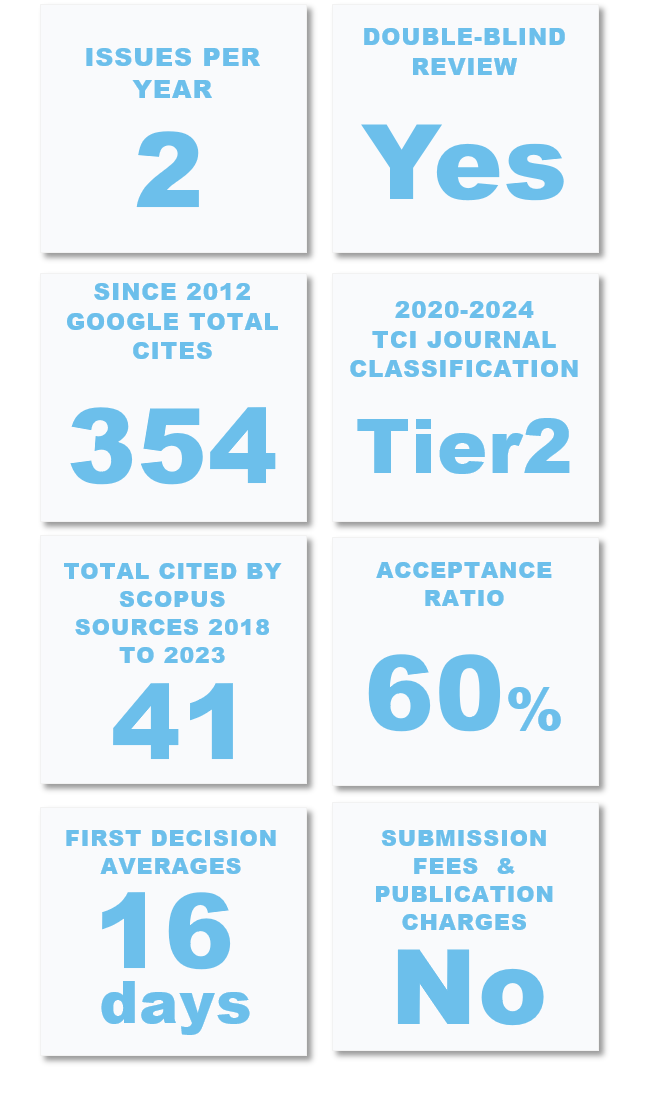Scenario-based Assessment of Decarbonized Transport Sector in Thailand towards Carbon Neutrality 2050
DOI:
https://doi.org/10.56261/built.v22.256385Keywords:
Decarbonization, Transport Sector, Carbon Neutrality, LEAP model, ThailandAbstract
Thailand's transport sector has been one of the highest CO2 emitters for several decades in the country due to the excessive increase in transport service demand and the high reliance on high-carbon-intensity petroleum fuels. This article discusses the potential of CO2 reduction in the transport sector in Thailand to achieve carbon neutrality by 2050. The Low Emissions Analysis Platform (LEAP) is adopted to estimate the future energy demand and CO2 emission between 2020 and 2050. This study designs two main scenarios, namely the Baseline (BAS) and the Decarbonization (DEC) scenarios. The BAS scenario is developed in a business-as-usual approach with frozen technologies, while the DEC scenario is constructed as a CO2 countermeasure by including multiple low carbon technologies such as i) improving fuel economy efficiency of engines, ii) promoting electric vehicles (EVs), iii) utilizing fuel cell electric vehicles (FCEVs), and iv) promoting mass transportation. The results indicate that by 2050, the transport sector's total energy demand will significantly increase to approximately 49,906 ktoe, with diesel, gasoline, and jet kerosene accounting for the majority of fuel consumption. In the BAS scenario, total CO2 emissions in the transport sector are estimated to be 119,737 ktCO2eq. By full implementation of the CO2 countermeasures and low carbon technologies in the decarbonization scenario, the total carbon emission in the transport sector is estimated to be 30,582 ktCO2 by 2050, which is in line with carbon neutrality pathways of Thailand. However, the nation-wide transport action plan should be developed in order to promote such sustainable transport technologies.
Downloads
References
Asian Development Bank. (2015). Thailand: Industrialization and economic catch-up [Report]. https://www.adb.org/publications/thailand-industrialization-and-economic-catch-up
Chunark, P., Thepkhun, P., Promjiraprawat, K., Winyuchakrit, P., & Limmeechokchai, B. (2015). Low carbon transportation in Thailand: CO2 mitigation strategy in 2050. SpringerPlus, 4(1). https://doi.org/10.1186/s40064-015-1388-6
Creutzig, F., Jochem, P., Edelenbosch, O. Y., Mattauch, L., Van Vuuren, D. P., McCollum, D., & Minx, J. (2015). Transport: A roadblock to climate change mitigation? Science, 350(6263), 911–912. https://doi.org/10.1126/science.aac8033
Department of Alternative Energy Development and Efficiency. (2024). Final energy consumption for transportation sector [In Thai]. Ministry of Energy. https://www.dede.go.th/articles?id=174&menu_id=67
Department of Land Transport. (2024). Information of vehicle registration database [In Thai]. https://web.dlt.go.th/statistics/
Duan, Z., Mei, N., Hong, J., Feng, L., Yu, S., Jiang, Z., Chen, D., & Xu, X. (2022). Research on hydrogen consumption and driving range of hydrogen fuel cell vehicle under the CLTC-P condition. World Electric Vehicle Journal, 13(1), 1–13. https://doi.org/10.3390/wevj13010009
Energy Policy and Planning Office. (2021). Energy statistics of Thailand 2021. Ministry of Energy.
Electric Vehicle Database. (2024). Electric vehicles database. https://ev-database.org/cheatsheet/energy-consumption-electric-car%0A
Global Fuel Economy Initiative. (2020). Vehicle efficiency and electrification: A global status report.
Iamtrakul, P., Iamtrakul, P., Satichob, P., Hokao, K., Satichob, P., & Hokao, K. (2018). Comparing the efficiency of urban components in proximity to transit service area. https://www.researchgate.net/publication/342396563
International Civil Aviation Organization. (2020). Air transport statistical results 2020.
International Energy Agency. (2021). Net zero by 2050: A roadmap for the global energy sector. https://www.iea.org/reports/net-zero-by-2050/
International Institute for Applied Systems Analysis. (2018). SSP database (Shared Socioeconomic Pathways 2018)-Version 2.0. https://tntcat.iiasa.ac.at/SspDb/dsd?Action=htmlpage&page=about#v2
Limmeechokchai, B., Lorm, R., & Thampanishvong, K. (2024). Analysis and modelling of power sector in Thailand. Sustainable Development Solutions Network. https://www.unsdsn.org/resources/analysis-and-modeling-of-power-sector-in-thailand-phase-2-2-report/
Limmeechokchai, B., Kongphunphin, C., Winyuchakrit, P., Pita, P., & Misila, P. (2024). Climate change 2022 mitigation of climate change: Urban system. International Journal of Building, Urban, Interior and Landscape Technology (BUILT), 22(1), 1–10. https://doi.org/10.56261/built.v22.251630
Limmeechokchai, B., Winyuchakrit, P., Pita, P., & Tatsuya, H. (2022). Decarbonizing transport sector in Thailand towards 2050. In Proceedings of the 2022 International Conference and Utility Exhibition on Energy, Environment and Climate Change (ICUE 2022) (pp. 1-7). IEEE. https://doi.org/10.1109/ICUE55325.2022.10113536
Mårtensson, H. B., Larsen, K., & Höjer, M. (2023). Investigating potential effects of mobility and accessibility services using the avoid-shift-improve framework. Sustainable Cities and Society, 96(August 2022). https://doi.org/10.1016/j.scs.2023.104676
Misila, P., Winyuchakrit, P., & Limmeechokchai, B. (2020). Thailand’s long-term GHG emission reduction in 2050: the achievement of renewable energy and energy efficiency beyond the NDC. Heliyon, 6(12). https://doi.org/10.1016/j.heliyon.2020.e05720
Ministry of Transport of Thailand. (2009). Transport Statistics 2009. https://doi.org/10.1080/03768358508439160
Ministry of Transport of Thailand. (2018). Transport Statistics 2018. https://datagov.mot.go.th/dataset/7c3d8945-fcb5-4f74-a69f-e757dd981bc1/resource/01dd8c9c-ae61-403e-bab8-74c220212003/download/transport-statistics-2018-complete.pdf
National Statistical Office of Thailand. (2021). Statistical Yearbook 2021.
National Statistical Office of Thailand. (2023). Statistical Yearbook 2023.
Office of Transport and Traffic Policy and Planning. (2023). Study of the policy to reduce energy consumption in the land transport sector.
Phoualavanh, S., & Limmeechokchai, B. (2016). Scenario-based analysis of co2 mitigation potential in the transport sector: Comparison between lao PDR and Thailand. Engineering Journal, 20(4), 111–119. https://doi.org/10.4186/ej.2016.20.4.111
Pongthanaisawan, J., Sorapipatana, C., & Limmeechokchai, B. (2007). Road transport energy demand analysis and energy saving potentials in Thailand. Asian Journal of Energy and Environment, 8(1–2), 49–72.
Rawiwan, C., Kronprasert, N., Sutheerakul, C., & Kii, M. (2019). Evaluation of urban traffic congestion externalities induced by Chiang Mai public transit systems. International Journal of Building, Urban, Interior and Landscape Technology (BUILT), 14, 93–102. https://doi.org/10.14456/built.2019.15
State Railway of Thailand. (2020). Annual report 2020.
Tsita, K. G., & Pilavachi, P. A. (2017). Decarbonizing the Greek road transport sector using alternative technologies and fuels. Thermal Science and Engineering Progress, 1, 15–24. https://doi.org/10.1016/j.tsep.2017.02.003
United Nations. (2024). World population prospects 2024. https://population.un.org/wpp/
United Nations Framework Convention on Climate Change. (2022). Thailand’s long-term low greenhouse gas emission development strategy. https://unfccc.int/sites/default/files/resource/Thailand LT-LEDS %28Revised Version%29_08Nov2022.pdf
U.S. Department of Energy. (2024). Fuel Economy: Alternative fuels. https://www.fueleconomy.gov/feg/current.shtml
Van der Zwaan, B., Keppo, I., & Johnsson, F. (2013). How to decarbonize the transport sector? Energy Policy, 61, 562–573. https://doi.org/10.1016/j.enpol.2013.05.118
Wimbadi, R. W., Djalante, R., & Mori, A. (2021). Urban experiments with public transport for low carbon mobility transitions in cities: A systematic literature review (1990–2020). Sustainable Cities and Society, 72(May), 103023. https://doi.org/10.1016/j.scs.2021.103023
Winyuchakrit, P., Sukamongkol, Y., & Limmeechokchai, B. (2017). Do electric vehicles really reduce GHG emissions in Thailand? Energy Procedia, 138, 348–353. https://doi.org/10.1016/j.egypro.2017.10.137
Wongchavalidkul, N., Sungsomboon, P.-Y., & Bakker, S. (2016, October 18). Monitoring greenhouse gas emissions in Thailand’s transport sector. Towards a measurement, reporting, and verification system for the land transport sector. Changing Transport. https://changing-transport.org/publications/monitoring-greenhouse-gas-emissions-in-thailands-transport-sector/
World Bank. (2024). World development indicators. https://databank.worldbank.org/source/world-development-indicators

Downloads
Published
How to Cite
Issue
Section
License
Copyright (c) 2024 International Journal of Building, Urban, Interior and Landscape Technology (BUILT)

This work is licensed under a Creative Commons Attribution-NonCommercial-NoDerivatives 4.0 International License.











